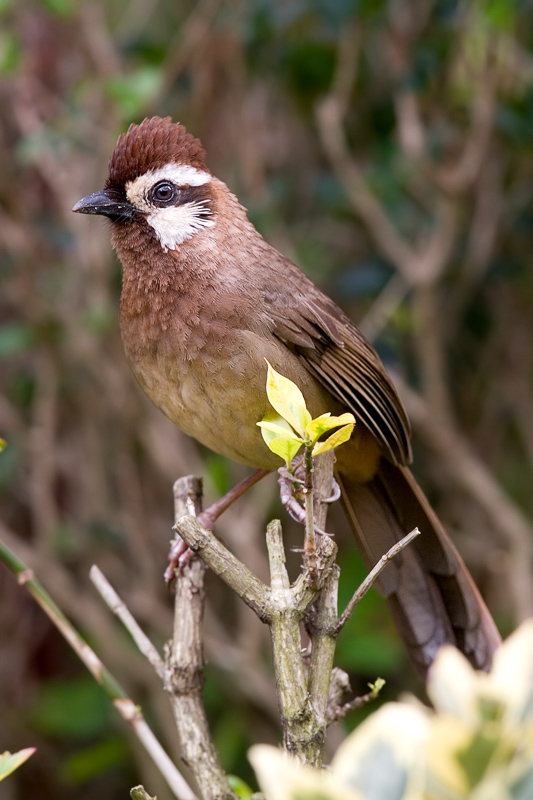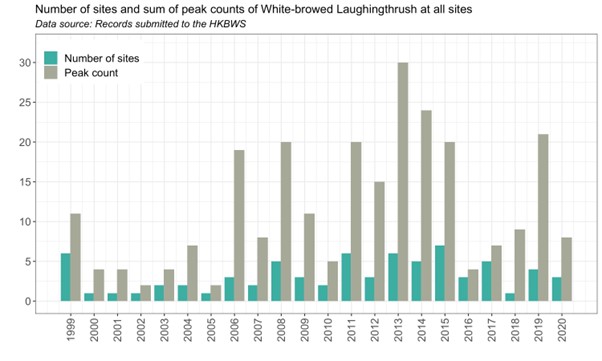White-browed Laughingthrush Pterorhinus sannio 白頰噪鶥
Category IIA. An uncommon and localised resident of both open and closed-canopy shrubland and shrubland edge. Much decreased since the 1980s but numbers apparently fairly stable this century.
IDENTIFICATION

Mar. 2007, Allen Chan.
22-24 cm. A rather small, neat and compact but long-tailed laughingthrush, medium brown all over, slightly more rufous on the vent. Distinctive head pattern with a dark brown chin and pure white supercilium joined in front of the eye to a white cheek patch.
VOCALISATIONS
Non-contact calls are generally loud and distinctive. Most prominent are sharply downslurred ‘pseeoo’ and ‘psrrroo’, the latter more buzzing. Subdued chattering notes function as contact calls. These can all be heard in the following recording.
The song in HK is unknown. However, in Thailand 1-4 loud clear notes of slightly varying pitch are uttered.
DISTRIBUTION & HABITAT PREFERENCE
Carey et al. (2001) discussed how both the range and population of White-browed Laughingthrush had declined since the early 1980s and speculated that if this decline continued it might disappear from HK. However, as is shown in Figure 1, White-browed Laughingthrush has not disappeared, but both the number of sites (no more than seven in any one year) and the estimated number of individuals (no more than 30) have both remained very small. As in the 1985 to 1998 period, sites have been scattered, but in the recent period most observations have come from the central New Territories, notably Lam Tsuen Valley and along the urban fringe and around villages southwest of Tai Po. Relatively large numbers reported from these areas are responsible for the apparent slight recovery in numbers recorded during 2011-15.
Some sites have held populations over many years: it was recorded from Cheung Chau (where it has been present from 1976, if not 1941) throughout the period, albeit regular observers consider it to be much declined. Similarly there are records from the Tai Po River Valley around Pun Shan Chau/Tai Tat Yan from at least 2001, Lead Mine Pass from 2003 and Lam Tsuen Valley, albeit again with a suggestion of recent decline, from 2005. Other sites where there was a long pattern of occupation but the population eventually disappeared include Chau Tau (present from at least the 1990s until 2008) and Ho Sheung Heung (present from 2009 to 2015).
Discerning population trends at individual sites is not easy, however; many of the records come from observers working their ‘local patch’ and hence changes in observer effort may obscure the real picture. Similarly, whilst White-browed Laughingthrush is not particularly shy and has a loud, distinctive, call, small numbers can be elusive. Its status on HK Island is a case in point. It was last recorded at the Zoolgical and Botanical Gardens (long a regular urban site) and Aberdeen Country Park in 1999 and was not seen on HK Island again until 2011 when five were seen at Shek O. There were then single unconfirmed reports at two sites in 2012 and 2015 (eBird 2023), but then no further records on the Island until 2017 when one was seen at nearby Cape D’Aguilar and 2019 when 15 (the highest count in the recent period) were recorded in three flocks, again at Shek O, in 2019.
Carey et al. (2001), suggested that habitat preferences of White-browed Laughingthrush in HK were rather hard to determine and noted observations had come from diverse habitats including shrubland/grassland mosaic, closed-canopy shrubland and urban parks. However, since its decline, the sites where it has persisted are more similar and largely comprise shrubland-grassland mosaic, often arising from abandoned farmland around villages or the urban fringe.
OCCURRENCE
Vaughan and Jones (1913) described White-browed Laughingthrush as ‘not a common’ resident, but contra Herklots (1936) it appears that they were referring to its status in Guangxi and Guangdong Provinces, where the sites that they mention are located, and not to HK. Thus, as is stated by Carey et al. (2001), who discussed in detail the history of White-browed Laughingthrush in HK, the first reference to its occurring in the territory was an observation on Cheung Chau in 1941 by Davies (Herklots 1953); though this record cannot now be substantiated, Cheung Chau has held a population of this species since at least 1976.
There were two urban records in 1961, and then regular reports from 1971 on HK Island. There was then an upsurge in records in the late 1970s from both HK Island and the New Territories, with the number of sites at which this species was seen peaking during 1977 to 1979 when it was recorded at 15 to 18 sites. It was initially considered that the records on HK Island referred to ex-captive birds (Webster 1975) but following the upsurge in reports and the establishment of breeding populations in several locations its status was re-evaluated and it was treated as a natural colonist by Chalmers (1986). However, numbers started to decline and birds disappeared from many sites from about 1985, and whilst there were fluctuations, there were records from only two to four sites during 1996 to 1998.
Carey et al. (2001) also discussed how the pattern of spread (a rather sudden appearance of relatively large number of birds on HK Island and in the New Territories in a diverse range of habitats including urban parks and both open degraded and closed-canopy shrubland) and the subsequent decline did not accord with natural colonisation, hence the decision to move the species to Category IIA (the then Category C).
Carey et al (2001) also stated that the pattern of establishment of the HK population showed no evidence of natural immigration and this remains the case today. Indeed, with the benefit of better knowledge of its distribution in China, notably from eBird, it has become apparent that in Guangdong, White-browed Laughingthrush is largely confined to the north of the province and only reaches the coast in the northeast around Shantou, with the closest observations to HK coming from northeast of Guangzhou (other than a city park record from Shenzhen) (eBird 2023). The HK population is thus isolated, and its placement in Category IIA seems appropriate; indeed, there is an argument it might be better placed in Category IIB (i.e. as an extralimital species with an established feral population in HK).
BREEDING
No information.
BEHAVIOUR, FORAGING & DIET
A typical laughingthrush, usually found in groups of several birds moving through shrubs and small trees, largely keeping low and sometimes on the ground, or flying across grassland between shrub patches. Not particularly shy and often quite noisy, perching in the open briefly, but more often within the vegetation.
Diet and foraging behaviour in HK are essentially unstudied. Corlett (1998) found fruit remains in one faecal sample, whilst Leven (2000) found a faecal sample to contain remnants of fruit and ants (Formididae).
RANGE & SYSTEMATICS
The range extends from northeast India, through Myanmar and northern Laos and Vietnam to most of southern and central China north to Shaanxi Province in the west and Shanghai in the east (Collar et al. 2021, Liu and Chen 2021). Outside its native range localised feral populations are found in parts of Taiwan and Japan (eBird 2023).
There are four subspecies, three of which occur in China. The nominate race is found in southeast China and is most likely the subspecies present in HK but birds here have not been critically examined.
CONSERVATION STATUS
IUCN: Least Concern. Population trend stable.
Figure 1.

Carey, G. J., M. L. Chalmers, D. A. Diskin, P. R. Kennerley, P. J. Leader, M. R. Leven, R. W. Lewthwaite, D. S. Melville, M. Turnbull and L. Young (2001). The Avifauna of Hong Kong. Hong Kong Bird Watching Society, Hong Kong.
Corlett, R. T. (1998). Frugivory and seed dispersal by birds in Hong Kong shrubland. Forktail 13:23-27.
Chalmers, M. L. (1986). Annotated checklist of the birds of Hong Kong. Hong Kong Bird Watching Society, Hong Kong.
Collar, N., C. Robson, and E. de Juana (2021). White-browed Laughingthrush (Pterorhinus sannio), version 1.1. In Birds of the World (J. del Hoyo, A. Elliott, J. Sargatal, D. A. Christie, and E. de Juana, Editors). Cornell Lab of Ornithology, Ithaca, NY, USA. https://doi.org/10.2173/bow.whblau1.01.1
eBird. 2023. eBird: An online database of bird distribution and abundance [web application]. eBird, Cornell Lab of Ornithology, Ithaca, New York. Available: http://www.ebird.org. (Accessed: 29 December 2023).
Herklots, G. A. C. (1936) The birds of Hong Kong. Part XXV. Family Timalidae (the babblers). Hong Kong Naturalist 7:215-217.
Herklots, G. A. C. (1953). Hong Kong Birds. South China Morning Post, Hong Kong.
Leven, M. R. (2000). Shrubland birds in Hong Kong: community structure, seasonality and diet. PhD. Thesis, University of Hong Kong.
Liu, Y. and S. H. Chen (eds) (2021). The CNG Field Guide to the Birds of China (in Chinese). Hunan Science and Technology Publication House, Changsha.
Vaughan, R. E. and K. H. Jones (1913). The birds of Hong Kong, Macao and the West River or Si Kiang in South-East China, with special reference to their nidification and seasonal movements. Ibis 1913: 17-76, 163-201, 351-384.
Webster, M. A. (1975). An annotated checklist of the birds of Hong Kong. Hong Kong Birdwatching Society, Hong Kong.

